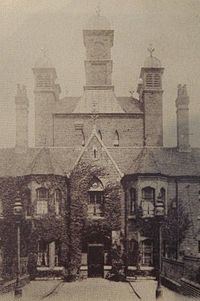 | ||
Statuses Rural district (1894–1898), Urban district (1898–1911) | ||
King's Norton and Northfield Urban District was a local government administrative district in north Worcestershire, England, from 1898 until 1911. Much of its area was afterwards absorbed into the neighbouring Borough of Birmingham, under the Greater Birmingham Scheme, and now constitutes most of the City’s southern and southwestern suburban environs.
Contents
Creation
The District was originally created in 1894 as the King's Norton Rural District, under the Local Government Act 1894, and succeeded the former King's Norton Rural Sanitary District upon which its area was largely based. It was later reconstituted as an urban district on 1 October 1898, by the Local Government Board Order, No. 38,127, and was accordingly renamed the King's Norton and Northfield Urban District. Both as a rural and an urban district it comprised only those civil parishes of the King's Norton Poor Law Union then wholly within the Administrative County of Worcester, namely the parishes of King's Norton, Northfield and Beoley.
Electoral Wards
The District was arranged into the following wards for the election of local councillors:
King's Norton Civil Parish
Northfield Civil Parish
Beoley Civil Parish
Committees
The District Council was organised into several committees with responsibility over a number of areas:
Baths, Parks and Cemeteries Committee
When the Committee was initially set up it was as the Cemeteries Committee, with a separate sub-committee that had specific responsibility for baths and parks. However, from May 1898 onwards, the Baths & Parks Sub-Committee ceased to exist and the Cemeteries Committee assumed their duties, altering its title to reflect this change.
Education Committee
The Committee was formed on 1 June 1903, and consisted of 40 members, of whom 28 were District Councillors.
Pensions Committee
The Committee had distinct sub-committees for the following areas of the District: King's Norton & Stirchley, Moseley & King's Heath, Wythall & Beoley, Northfield, and Selly Oak.
Distress Committee
The Committee consisted of 25 members, of whom 12 were District Councillors, 8 were Guardians of the King's Norton Poor Law Union, and the remaining 5 were "persons experienced in the relief of distress".
Demography
According to the 1911 census the District had a population of 81,153, large enough to become a county borough.
Amenities and services
During its existence the District Council provided public amenities for its populace in the form of two cemeteries, two swimming baths, several parks and recreation grounds, and a handful of free libraries. The Council also ran a number of elementary schools, as well as being responsible for the local volunteer fire service:
Free Libraries
Proposals for the provision of Free Libraries in the District were first mooted in 1902, and following the adoption of the Libraries Acts the next year, a scheme to establish libraries throughout its area was set up. Between 1905 and 1909 seven new libraries were built across the District, with the land being donated by local philanthropic businessmen and the building work funded through the benevolence of Dr Andrew Carnegie.
Council Schools
Until the 1902 Education Act, elementary education within the District was provided through a combination of a number of voluntary schools established by religious organisations, such as the Church of England National Schools and the non-denominational British Schools, together with those schools built and maintained by the local School Boards for King's Norton and Beoley, who had been set up in the wake of the Elementary Education Act 1870. Under the 1902 Act the Urban District Council was designated a Local Education Authority, and thereafter assumed the duties of the former King's Norton and Beoley School Boards, which were accordingly abolished, inheriting their existing school buildings, as well as being given the power to establish new elementary schools within the area.
Abolition
The Urban District was finally abolished in 1911 as part of the provisions of the Greater Birmingham Act, when much of its area was incorporated into the County Borough of Birmingham, and thereby became associated with Warwickshire. This included the greater part of the civil parish of King's Norton, with the exception of a substantial still largely rural area in the south-east of the parish, which afterwards constituted the new civil parish of Wythall, as well as a small part of Rednal in the far south-west, which was added to the civil parish of Cofton Hackett. It also included most of Northfield civil parish, save for a little under 200 acres at its extreme north-western tip which was transferred to the civil parish of Illey, then part of the Halesowen Rural District. It did not, however, include Beoley civil parish, which remained in Worcestershire, and which, along with Wythall, initially formed a separate rural district temporarily administered by the Bromsgrove Rural District Council, until both became part of that district on 31 March 1912.
